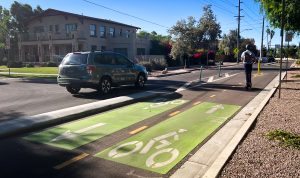Orange-barrel season is in full swing (though actually, the season seems to last year-round lately), and why not put the time you spend in bumper-to-bumper construction traffic to good use? Creeping along in traffic lately, gazing through the windshield, I’ve spotted a number of potential story angles that would resonate with readers, highlight interesting aspects of the industry and even reflect certain characteristics of the local economy and jobs market.
For example, it seems that even the job of putting out pylons and halting traffic has gone high tech. Rather than the paving contractors or, on local roads, city workers setting up the cautionary markers, I noticed that a commercial third-party firm was handling that. A quick Google search turned up firms like Traffic Management Inc. and Area Wide Protective that offer a variety of traffic control “solutions” for states and other clients. What an interesting specialty to profile.
What sort of credentials, training and expertise is required, for example, to plan multi-lane shutdowns for big road projects, or to organize lane shifts and the like? What do these companies charge for their services? Are there smaller, local players in your neck of the woods, and how did they get started? I think readers would enjoy an inside glimpse of the career possibilities and revenue streams behind the orange cones.
Beyond concrete and asphalt, the nearly $50 billion-a-year road construction business is fertile ground for a variety of business angles, from small-contractor and labor stories to materials and supply issues to an examination of which firms are winning the most contracts from state and local road overseers, and why. The market research firm IBISWorld is out with a new report on the industry, which it says comprises about 4,400 firms in the United States, and creates nearly $10 billion in wages; the full report is available to reporters via a request to the IBISWorld Media Center. And an April report by the American Road and Transportation Builders Association, a lobbying/trade organization, also assesses the impact of road construction on the economy, including an interactive state-by-state map that points you to state-specific reports. (Note that these reports include non-road projects like airports, but it’s a good starting point for information.)
You can find firms with contracts in your state by checking out the requests-for-proposals and bidding sites at your state’s transportation department, like this one from Virginia. It would be interesting to look at patterns of contract awards throughout your region. Are any start-ups or “little guys” getting a crack at road jobs; the IBISWorld report notes that it’s a sector with very low barriers to entry so you might find some young companies. The AASHTO, the organization for state transportation officials, has an interesting national website, too.
Green highways?
Ask the transportation department, contractors and vendors about green trends in road-making, from materials to the type of highway-side landscaping choices being made this way. Here’s an article from Canada about a firm that recycles concrete from demolished buildings for use in road construction, and here’s one from the Times of Trenton about an in-place asphalt recycling method being used in that area. (Even ask about construction codes for rest areas, which in some areas are using geothermal energy, wind turbines and other sustainable means to reduce their environmental impact.)
Who suffers?
It’s not a new idea, but do check with retailers, tourism venues and other businesses along construction sites, to determine the effect on them. Near me, a suburban four-lane road built two years ago still is flanked by totally empty strip malls whose tenants failed during a drawn-out construction project. No new takers for those storefronts, either.










